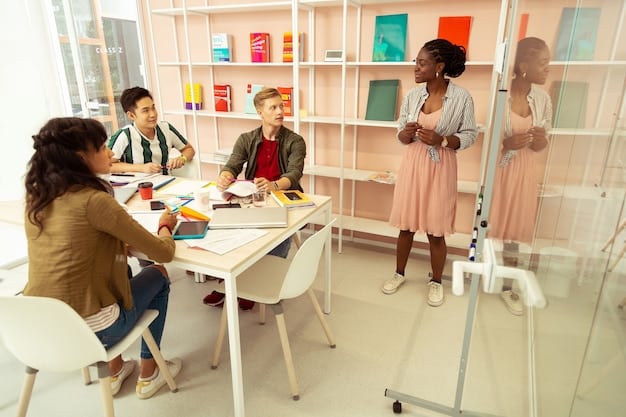Promoting Social Justice: Inclusive Learning Environments in US Schools

US schools can promote social justice education and create inclusive learning environments by implementing culturally responsive teaching, diversifying curriculum, providing professional development, fostering student voice, and addressing systemic inequalities.
Creating inclusive learning environments and promoting social justice education in US schools is essential for fostering equity and preparing students to become informed and engaged citizens. It involves addressing systemic inequalities and ensuring all students feel valued and respected.
Understanding Social Justice Education
Social justice education is more than just teaching about historical events; it’s about empowering students to recognize, analyze, and challenge systems of inequality and oppression. It aims to create a society where everyone has equal access to opportunities and resources, regardless of their background.
Key Principles of Social Justice Education
This educational approach focuses on several key principles that guide its implementation and impact.
- Equity: Ensuring fair access to opportunities and resources for all students, recognizing that individuals may require different supports to achieve equal outcomes.
- Empowerment: Fostering students’ ability to advocate for themselves and others, promoting agency and self-efficacy.
- Critical Thinking: Encouraging students to analyze power structures and social norms critically, developing their ability to question and challenge injustice.
By embracing these principles, schools can cultivate a generation of empathetic and engaged citizens committed to creating a more just society.

Implementing Culturally Responsive Teaching
Culturally responsive teaching recognizes the importance of incorporating students’ cultural backgrounds and experiences into the learning process. It acknowledges that students learn best when they see themselves reflected in the curriculum and feel valued for their unique identities.
This approach goes beyond simply acknowledging diversity; it involves actively integrating students’ cultures into the fabric of the classroom.
Strategies for Culturally Responsive Teaching
Here are some practical strategies for implementing culturally responsive teaching in US schools:
- Know Your Students: Take the time to learn about students’ backgrounds, interests, and learning styles. Use this knowledge to tailor instruction to their individual needs.
- Incorporate Diverse Perspectives: Integrate diverse voices and perspectives into the curriculum, showcasing contributions from people of different races, ethnicities, genders, and sexual orientations.
- Create a Safe and Inclusive Classroom: Establish a classroom environment where students feel safe to share their thoughts and experiences, and where discrimination and prejudice are not tolerated.
By implementing these strategies, educators can create a learning environment that is more engaging, relevant, and equitable for all students.
Diversifying Curriculum and Resources
A diverse curriculum is one that reflects the rich tapestry of human experience, representing a wide range of perspectives, histories, and cultures. Diversifying curriculum and resources is a critical step in promoting social justice education.
Traditional curricula often focus on dominant narratives, marginalizing the stories and experiences of underrepresented groups.
Steps to Diversify Curriculum
- Review Existing Materials: Evaluate current textbooks, readings, and other instructional materials for bias and representation.
- Seek Out Diverse Resources: Actively seek out books, articles, and multimedia resources that represent diverse perspectives and challenge dominant narratives.
- Engage with Community Partners: Collaborate with local organizations and community leaders to bring diverse voices and experiences into the classroom.
By diversifying curriculum and resources, schools can provide students with a more comprehensive and accurate understanding of the world and empower them to become critical thinkers and engaged citizens.
Providing Professional Development for Educators
Effective social justice education requires educators to be knowledgeable, skilled, and committed to creating inclusive learning environments. Providing professional development for educators is essential to equip them with the necessary tools and resources.
Many educators may not have had specific training in social justice education during their teacher preparation programs.

Key Areas for Professional Development
Professional development programs should focus on several key areas:
- Cultural Competence: Training educators to understand and respect the cultural backgrounds of their students, and to navigate cultural differences effectively.
- Implicit Bias: Raising awareness of unconscious biases and how they can impact teaching practices and student outcomes.
- Anti-Racism Education: Providing educators with the knowledge and skills to address racism and other forms of discrimination in the classroom and beyond.
By investing in professional development, schools can ensure that educators are well-prepared to promote social justice education and create inclusive learning environments.
Fostering Student Voice and Agency
Empowering student voice and agency is a cornerstone of social justice education. When students feel heard and valued, they are more likely to engage in learning, advocate for themselves and others, and become active participants in their communities.
Creating opportunities for students to share their perspectives, experiences, and ideas is crucial for fostering a sense of belonging and empowerment.
Methods for Fostering Student Voice
- Student-Led Discussions: Facilitate classroom discussions where students have the opportunity to share their thoughts and perspectives on social justice issues.
- Student Advisory Boards: Establish student advisory boards to provide input on school policies and practices related to diversity, equity, and inclusion.
- Youth Participatory Action Research: Engage students in research projects focused on addressing social justice issues in their communities.
By fostering student voice and agency, schools can create a more democratic and equitable learning environment where all students feel empowered to make a difference.
Addressing Systemic Inequalities
Social justice education must address systemic inequalities that affect students’ access to opportunities and resources. Factors such as race, ethnicity, socioeconomic status, and disability can create barriers to learning and success.
Schools play a critical role in dismantling these barriers and creating a more equitable playing field for all students.
Strategies for Addressing Systemic Issues
- Equitable Resource Allocation: Ensure that resources are distributed fairly across schools, taking into account the needs of students from marginalized communities.
- Addressing Achievement Gaps: Implement targeted interventions to address achievement gaps between different student groups, providing additional support to those who need it most.
- Challenging Discriminatory Policies: Review and revise school policies and practices that disproportionately affect students from marginalized communities.
By actively addressing systemic inequalities, schools can create a more just and equitable learning environment for all students, promoting social mobility and empowering them to reach their full potential.
Collaboration with Families and the Community
Creating truly inclusive learning environments requires collaboration among schools, families, and the broader community. Families are integral to students’ lives, and their involvement is crucial for reinforcing social justice values and fostering a sense of belonging.
Community partnerships can provide valuable resources and support to schools, enriching the learning experience for students and connecting them to real-world opportunities.
Building Stronger Connections
- Family Engagement Programs: Develop programs that engage families in their children’s education, providing opportunities for them to share their experiences and perspectives.
- Community Partnerships: Collaborate with local organizations, businesses, and community leaders to provide resources and support to schools.
- Cultural Events and Celebrations: Organize events that celebrate the diversity of the school community, promoting understanding and appreciation of different cultures.
By fostering collaboration with families and the community, schools can create a more supportive and enriching learning environment for all students, embedding social justice values in the fabric of the community.
| Key Aspect | Brief Description |
|---|---|
| 🍎 Culturally Responsive Teaching | Incorporate students’ cultural backgrounds into teaching methods. |
| 📚 Diversified Curriculum | Utilize a variety of resources that offer diverse perspectives. |
| 🧑🏫 Educator Development | Train educators in cultural competence and anti-bias methods. |
| 🗣️ Student Voice | Encourage and value student input to foster equity. |
Retractable FAQ Section
▼
Social justice education aims to empower students to recognize, analyze, and challenge systems of inequality. It promotes a society where everyone has equal opportunities, regardless of background.
▼
Culturally responsive teaching values students’ cultural backgrounds, making education more engaging and relevant. It helps students feel seen, understood, and respected in the classroom.
▼
Schools can diversify their curriculum by reviewing existing materials, seeking out diverse resources, and engaging with community partners to include a variety of voices and perspectives.
▼
Professional development is crucial for equipping educators with the knowledge and skills to create inclusive learning environments. It includes training in cultural competence, implicit bias, and anti-racism.
▼
Fostering student voice empowers students by creating opportunities for them to share their perspectives on social justice issues. This helps to promote a more democratic and equitable learning environment.
Conclusion
Promoting social justice education and creating inclusive learning environments in US schools is a multifaceted endeavor that requires ongoing commitment and collaboration. By implementing culturally responsive teaching, diversifying curriculum, providing professional development, fostering student voice, addressing systemic inequalities, and collaborating with families and the community, schools can create a more just and equitable learning environment for all students, empowering them to become informed, engaged, and compassionate citizens.





